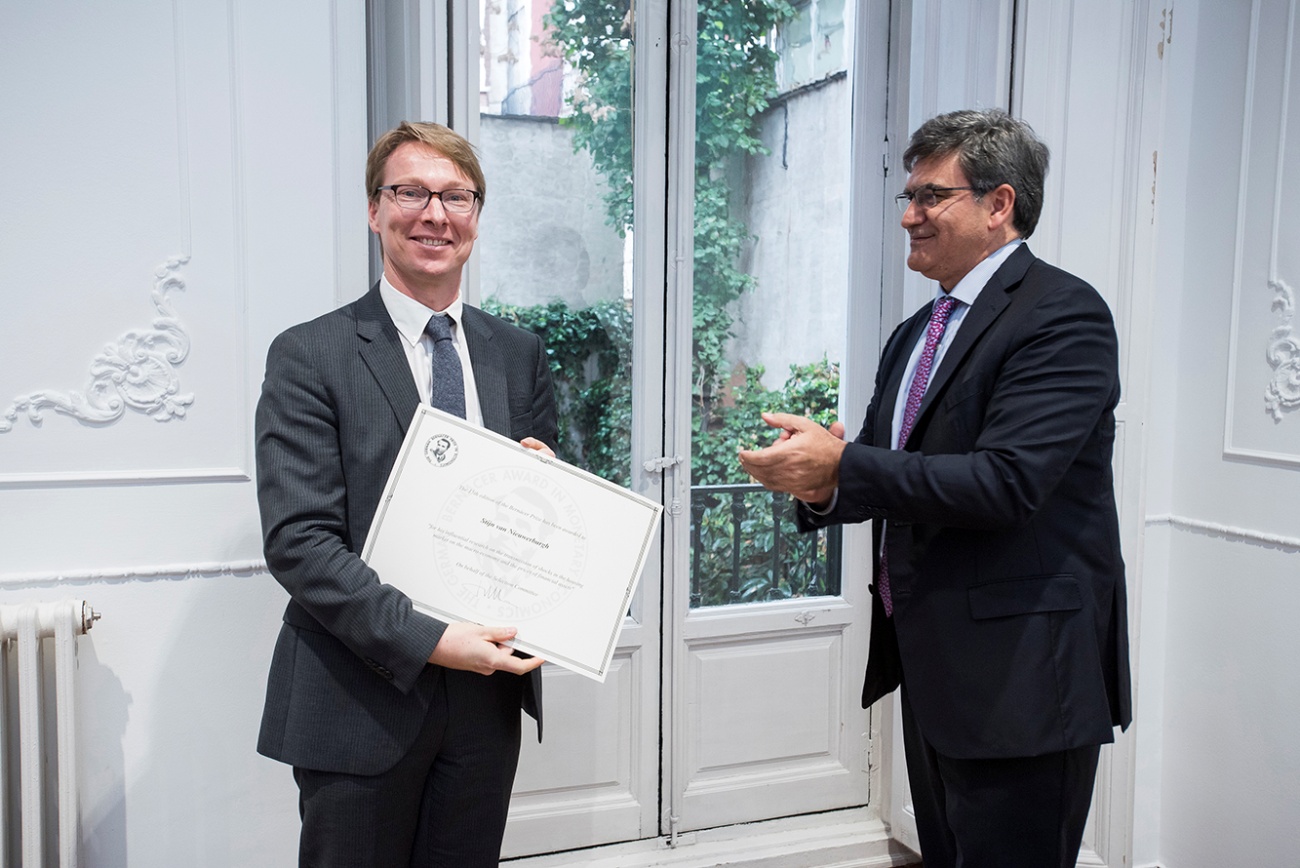Estimado Sr. Linde, Sr. Constanzio, Sr Alvarez, Sr. De la Dehesa,
Es un gran honor estar aquí como laureado del premio Bernácer. Tengo un respeto enorme para el profesor Bernácer, fundador del departamento de investigación de Banco de España y uno de los padres de la Macroeconomía. Hoy es un día muy feliz y me alegro mucho que mis padres y hermano han podido estar conmigo aquí en esta ceremonia. Hace unos 20 años que ya no he estado en Madrid después del verano del noventa-y-seis cuando pasé un verano trabajando como becario en Madrid, descubriendo su belleza. Ahora paso a inglés.
I would like to thank the committee for the great honor in having selected me to receive this wonderful award. I would like to thank my parents and brother for being here and for all the support they have given me over the years. The same goes for my wife Laura who regrettably cannot be here today. She has taken the much more arduous task upon herself of traveling with our two young sons to the National chess championships in Nashville, Tennessee this weekend. I also owe a great debt of gratitude to my PhD dissertation advisors Prof. Sargent, Hall, and Krueger, and all my co-authors and colleagues at NYU Stern from whom I have learned so much.
As was mentioned, I was awarded the prize for my work that lies at the intersection of real estate, macro-economics, and finance. I think that, at least in part, I was lucky to have started working on this topic during my PhD dissertation in 2003, several years before it became painfully clear just how crucial that nexus was during the Great Recession of 2008.
In my remarks today, I would like to reflect on the role that real estate played in the crisis, highlight a few things that we have learned from recent academic research in this area, and finish with some thoughts on current policy challenges, and why policy makers need to remain vigilant today.
The first simple point I would like to make is that the real estate sector was and remains a crucial sector in the economy. Let me take Spain as an example. Investment in residential and commercial real estate accounted for 8% of GDP and 33% of all investment in 2006. 10% of all jobs in Spain were in construction and other real estate activities. Houses are the largest source of wealth for households. Spain has a high, 80% home ownership rate, and housing wealth accounts for 87% of all wealth of Spanish households. Mortgages make up 80% of household debt and are a major asset of the banking sector.[1] These numbers are not unique to Spain. With only a few exceptions like Germany and Switzerland, home ownership rates in Western European countries are high, and housing wealth and mortgages make up the lion share of household assets and liabilities, respectively.
That the real estate sector was a critical component of the financial system and the macro-economy became abundantly clear during the Great Recession that started in 2008.
In the United States, the largest financial crisis since the Great Depression had its origins in excessive lending against residential and commercial real estate. In the years leading up to the crisis, U.S. banks had made too many high-risk mortgage loans. These loans often required minimal down payments from the borrower, had ultra-low initial monthly payments, and did not require the verification of the borrower’s income or assets. Banks were willing to make these loans because they never intended to hold these loans on their balance sheet. Rather, they sold the mortgages to investors through so called mortgage-backed securities. While it is in principle a good idea for banks to share the default and interest rate risk associated with mortgages with other investors through the capital markets, the execution of these securitizations left much to be desired. The credit ratings agencies who had to vouch for the safety of these MBS dropped the ball.
The expansion in the supply of housing credit, arguably driven by a relaxation of lending standards, combined with the low interest rate environment, go a long way towards explaining the large housing boom in the 2000-2006 period, as I show in work with Jack Favilukis and Sydney Ludvigson.[2]
When house prices stopped growing in June 2006, after 11 years of uninterrupted price increases, it did not take long before many households started defaulting on their mortgage loans.
Households who were over-levered stopped spending and stopped investing in their house. The reduced demand for goods forced firms to lay off workers. The households who lost their job, were often unable to make their mortgage payments and ended up in foreclosure. The foreclosure sales put further downward pressure on house prices.
Investors in mortgage-backed securities, including many U.S. and European banks, lost massive amounts of money. New residential mortgage-backed security originations stopped almost overnight. Banks who became dangerously undercapitalized tightened lending standards, making it more difficult for households to buy their first home or refinance an existing mortgage, and making it more difficult for businesses to obtain credit. This credit crunch further amplified the downturn and made it more protracted.
Other households could not take advantage of the lower interest rates by refinancing their mortgage because their house had fallen in value to the point where they owed more debt than their house was worth. This under-water situation prevented them from moving to other locations were there still may have been jobs. One of America’s greatest assets, the mobility of its people, suffered.
Much academic work has been done on how the consequences of over-indebted households, and the consequences for the weak economic recovery that followed the Great Recession. For example, there is evidence from household-level data that the marginal propensity to consume out of housing wealth was unusually high during the bust. Extrapolating to the economy as a whole, the massive decline in housing wealth we saw contributed meaningfully to the weak aggregate spending.
All in all, 7 million households lost their homes in foreclosure in the United States. They lost more than just financial wealth. They ruined their credit record. They lost a collateral asset they could borrow against to send their children to college or to pay for an expensive medical procedure. And –maybe- they and their children lost faith in the American dream of becoming a home owner.
An entire cohort of millennials graduated into a weak labor market, decided to postpone forming their own households, and faced tight lending standards when trying to get a mortgage. The millennials have the lowest home ownership rates of their age group in history. Home ownership is one of the mainstays of the middle class and a key wealth accumulation tool seems out of reach for many households.[3]
The story of the financial crisis in Europe shows many resemblances. It too, was very much a real estate crisis, with Spain and Ireland as the poster children. In November 2010, after the property bubble burst, leaving Irish banks with €100 billion in non-performing loans, Ireland had to ask the European Union and the IMF for a bail-out package. Spain, Greece, Portugal and Cyprus also had massive amounts of capital and loans tied to the real estate and construction sectors, and banks suffered large losses in collateral and income backed by real estate assets.[4] In Spain’s property bust, the employment share in real estate fell from 10.5% to 6.5% of all jobs. Construction activity has been depressed ever since. As a result of the property bust, many of the construction workers found their way into the pool of long-term unemployed. This is especially problematic given that at least some ended their schooling early to take advantage of the real estate boom. This human capital deficit will have persistent effects on the long-run output potential of the economy.
Because much more of European funding for residential and commercial real estate in Europe is done by banks, the declines in property values increased the number of non-performing real estate loans. This weakened banks’ balance sheets and contributed to the credit crunch which ensued. European banks cut lending by 11 trillion euros between 2009 and 2013. Acoording to work by Luque and Melo, 1 trillion of that 11 trillion is a deficit in commercial real estate lending. This in turn has held back the recovery in property markets.
In contrast with the United States, the European residential and commercial mortgage securitization markets never recovered, making it hard for many European households and firms to get a residential or commercial mortgage.
I would like to conclude by outlining what I see as three important policy challenges at the intersection of real estate, finance, and the macro-economy. These challenges all start from the observation that real estate represents a systematic source of risk. The Great Recession has taught us that residential and commercial property prices tend to move together, in cycles that are coordinated not only across regions in a country, but also across countries. Just think of our prior discussion of the U.S., Ireland, and Spain. Given their critical role for the well-functioning of the broad economy, banks may not be the best institutions to hold onto that systematic real estate risk. After all, we would not want a downturn in property markets to impair banks’ ability to lend to the rest of the economy. This raises the question of how to set regulation to provide for proper incentives, and how to involve capital markets to provide a good alternative source of funding for residential and commercial loans.
The first policy challenge, which strikes me as especially pressing for Europe, is to get private residential mortgage securitization going again. A healthy securitization market allows banks to originate real estate loans but to pass on the interest rate and default risk to capital markets investors. In Europe, the ECB, the EIB and the Commission have supported securitization markets through several new initiatives over the past five years. Those initiatives are important steps towards nursing European real estate debt markets back to health. More still needs to be done to restore the trust of investors, and to create a transparent and securitization-friendly regulatory environment. Some recent developments threaten to disadvantage the regulatory capital treatment of securitized assets and risk chasing securitization activity underground to private transactions. I believe that a stronger securitization would give Europe a more resilient financial system that is ultimately better able to serve the real estate sector and the real economy more broadly.
The second big policy challenge is in the United States. An important item of unfinished business from the Great Recession is the reform of the residential mortgage market. Since its rescue of Fannie Mae and Freddie Mac in 2008 and a big expansion in the Federal Housing Administration and Veterans Administration mortgage programs, the U.S. government has kept a dominant footprint in the U.S. housing finance system to this day.[5] Because the system gives so many regulatory advantages to the government, it effectively prevents a rebirth of the private mortgage market. The U.S. taxpayer remains on the hook for the bulk of the default risk in the mortgage market. My research shows that a return to a private-market system without government guarantees would be welfare-improving. Much of the welfare improvements would come from safer mortgage lending. The government guarantees now give banks an incentive to make too many mortgages and to make mortgages that are too risky. The incoming Treasury Secretary in the Trump administration has indicated that he favors re-privatizing Fannie and Freddie. While bringing private capital back in the market is imperative, I think we need to make a clean break with the past and dissolve Fannie and Freddie. We cannot afford to simply return to a system that has the same design flaws of the past. Rather, we need a new housing finance system that allows private investors to bear the vast majority of the interest rate and credit risk through well-functioning securitization markets.
The third and final policy challenge is how to design proper macro-prudential policies that disincentivize banks from loading up on systemic risk in real estate. Indeed, the economic history work of Jorda, Shularick, and Taylor teaches us that most of the financial crises in the Western world after World War II were associated with mortgage crises, and that these crises were very disruptive for the real economy. Unfortunately, it may be time to start worrying again about elevated property prices. Last week, the IMF reported that worldwide house prices have recovered to their pre-crisis levels. They have risen strongly in the U.S. and in several European countries. The same is true for commercial property markets especially in large cities like New York, London, and Paris, where prices have exceeded pre-recession peaks. The ultra-low interest rates of the last several years are partly to blame as they have pushed many large institutional investors, like pension funds and sovereign wealth funds, to increase their holdings in real estate in search for yield.[6]
The European Systemic Risk Board warned last month that fast house price appreciation, combined with a rising fraction of heavily indebted borrowers, and the exposure of the banking sector to real estate loans present a dangerous situation in 8 European countries, including my home country of Belgium.
The good news is that there is now a dashboard that allows the ESRB and the ECB to track the situation in each country closely. To help central banks and supervisors to better monitor the financial system’s exposure to CRE, it is important that granular and consistent data are made available. This is a 2015 European Systemic Risk Board recommendation I fully endorse.
Even more importantly, banking supervision authorities have already taken useful measures to cool down property markets. Those measures include imposing extra bank capital requirements for loans with high debt payment-to-income ratios or high loan amount to property value ratios. Closely monitoring underwriting standards and rigorous stress testing of bank health in the event of an adverse real estate price shock will all help to identify vulnerabilities and put in place prompt corrective action that can limit the risk of the next real estate credit bubble.
One lesson that emerges from my recent work on such macro-prudential policies is that there is a trade-off that needs to be navigated carefully. The best policies strike a balance between making the financial system safer and the macro-economy less volatile, while not overly constraining the credit that can flow to the real economy. [7]
The combination of thoughtful macro-prudential bank regulation and deeper securitization markets would go a long way towards creating a safe and deep mortgage finance market.
In conclusion, it has been an incredibly exciting decade for researchers like me, working at the intersection of finance, macro-economics, and real estate. The exponential growth of academic work and policy experience on the ground has substantially improved our understanding of these linkages. It makes me hopeful that the next decade will be a little bit less exciting, and that the next crisis will not be a real estate crisis. Then, the real estate sector can go back to simply fulfilling its role of delivering the beautiful places where we all work and live.
[1] Lustig and Van Nieuwerburgh (2005, 2010) emphasize the role of housing as a collateral asset and explore its implications for asset pricing. Koijen, van Hemert, and Van Nieuwerburgh (2009) focus on the mortgage choices of U.S. households. Davis and Van Nieuwerburgh (2015) summarize the literature on housing, finance, and the macro-economy. Van Nieuwerburgh and Weill (2010) discuss the joint evolution of regional incomes and house prices.
[2] Favilukis, Ludvigson, and Van Niuewerburgh (2016) studies the boom and bust in the U.S. housing market and emphasize that relaxation of lending standards endogenously lower risk premia. The other important ingredient is foreign holdings of U.S. Treasuries. Kohn, Favilukis, Ludvigson, and Van Niuewerburgh (2013) take an international perspective. Van Nieuwerburgh (2012) discusses this research agenda.
[3] Sodini, Van Nieuwerburgh, Vestman, von Lilienfeld-Toal (2016)
[4] Luque & Mello (2016)
[5] Acharya, Richardson, Van Nieuwerburgh, and White (2010); Elenev, Landvoigt, and Van Nieuwerburgh (2016)
[6] Van Nieuwerburgh, Stanton, de Bever (2015), Koijen and Van Nieuwerburgh (2017)
[7] Elenev, Landvoigt, and Van Nieuwerburgh (2016a, 2016b)



